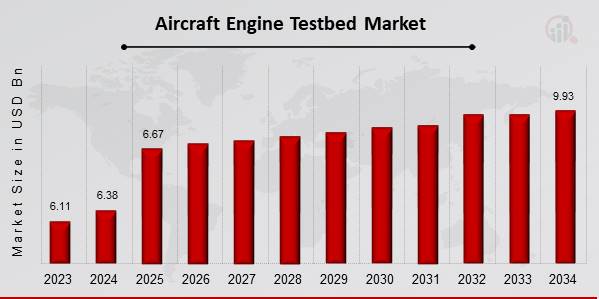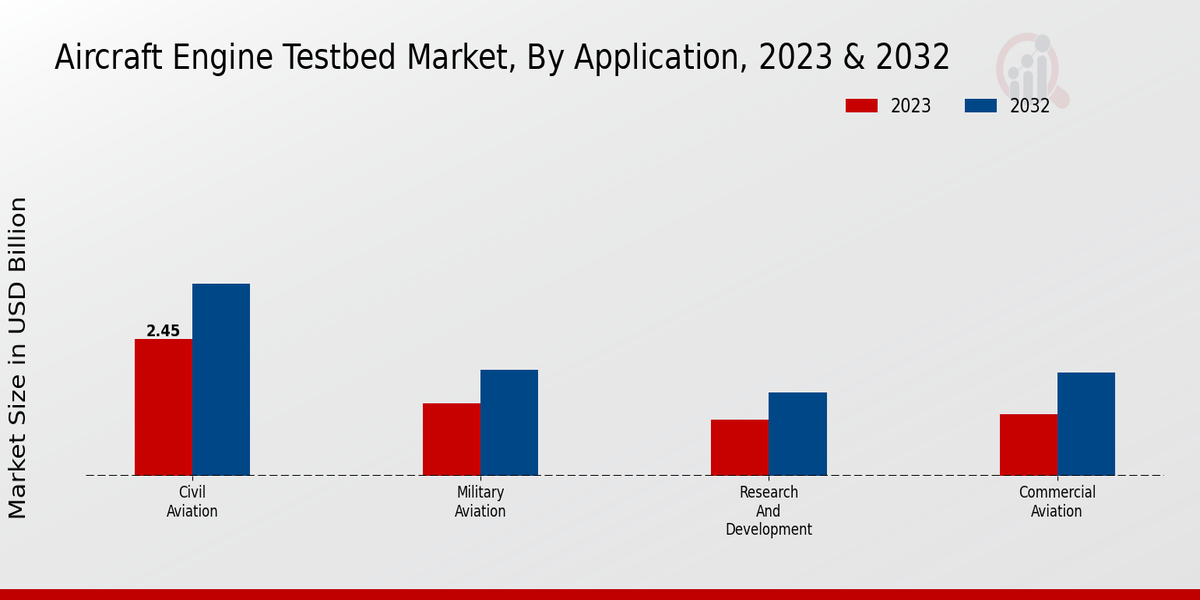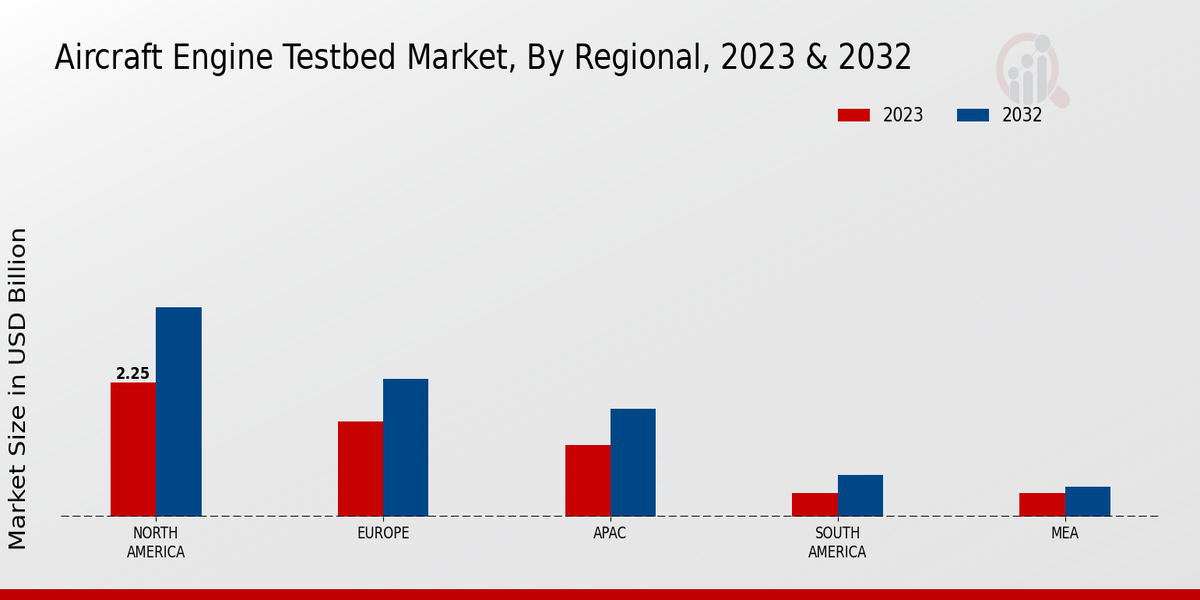Global Aircraft Engine Testbed Market Overview
Aircraft Engine Testbed Market Size was estimated at 6.38 (USD Billion) in 2024. The Aircraft Engine Testbed Industry is expected to grow from 6.67 (USD Billion) in 2025 to 9.93 (USD Billion) by 2034. The Aircraft Engine Testbed Market CAGR (growth rate) is expected to be around 4.5%% during the forecast period (2025 - 2034).

Source Primary Research, Secondary Research, MRFR Database and Analyst Review
Key Aircraft Engine Testbed Market Trends Highlighted
The aircraft engine testbed market is witnessing significant growth fueled by increasing demand for fuel-efficient and high-performance engines. As airlines seek to enhance operational efficiency and reduce emissions, testbed facilities play a crucial role in ensuring that engine designs meet stringent safety and performance standards. The push for innovation in aviation technology, including the development of sustainable aviation fuels and electric propulsion systems, further drives the need for advanced testing capabilities. Opportunities exist in the development of specialized testbed facilities that can accommodate a variety of engine types, including hybrid and electric engines.There is a growing demand for retrofitting existing testbeds with advanced technology to support new engine designs. Partnerships between manufacturers and testing service providers can lead to the sharing of resources and expertise, enhancing testing efficiency. Additionally, the rising number of aircraft deliveries and maintenance, repair, and overhaul (MRO) services presents a chance for market expansion as testbed facilities cater to more clients in the aviation sector. Recent trends indicate a movement towards digitalization in the testing process. The integration of data analytics, simulation, and real-time monitoring enhances testing accuracy and efficiency.Testbeds are increasingly incorporating automation, reducing manual intervention and allowing for more precise data collection. The emphasis on sustainability is also evident, with many facilities adopting cleaner technologies and practices to minimize their environmental footprint. The need for stringent regulatory compliance is driving operators to innovate and improve their testing methodologies continuously. In summary, the aircraft engine testbed market stands at a pivotal point, with opportunities for technological advancements and collaborative efforts to meet the evolving demands of the aviation industry.
Aircraft Engine Testbed Market Drivers
Increasing Demand for Fuel Efficiency
One of the most significant drivers of the Aircraft Engine Testbed Market Industry is the growing demand for fuel-efficient aircraft engines. As the aviation sector continues to expand, airlines are increasingly prioritizing operational efficiency and cost reduction. Investment in advanced aircraft engine technologies through rigorous testing necessitates the utilization of aircraft engine testbeds, which are critical for evaluating engine performance and durability under various conditions.The emphasis on reducing carbon emissions and adhering to stricter environmental regulations compels manufacturers to innovate and optimize engine designs, thereby resulting in enhanced fuel efficiency. Aircraft engine testbeds play a pivotal role in this process, allowing engineers to test prototypes and iterate designs quickly. Furthermore, as the aviation market trends toward smaller, more efficient engines, the necessity for precise testing becomes paramount, reinforcing the relevance of the Aircraft Engine Testbed Market Industry.Developing new, sustainable aviation fuels also ties into the testing processes that testbeds provide, as they enable risk-free evaluations and comparisons of alternative fuel sources, ensuring compatibility with next-generation engines. As airlines look to modernize their fleets with engines that not only meet performance standards but also align with long-term sustainability goals, the reliance on advanced testing facilities is expected to surge, propelling market growth significantly.
Advancements in Aerospace Technology
Technological advancements within the aerospace sector are driving the growth of the Aircraft Engine Testbed Market Industry. Innovations such as additive manufacturing, digital twin technology, and advanced materials are transforming the development of aircraft engines. These cutting-edge technologies require extensive validation processes, which can only be achieved through sophisticated testbed facilities. The implementation of new materials that enhance engine performance and reduce weight showcases the critical need for rigorous testing to ensure safety and reliability.Moreover, the adoption of digitalization and data analytics in engine testing processes enhances efficiency, reduces development time, and allows for real-time monitoring of engine performance. Such advancements underline the importance of modern testbeds, which are equipped to support the continually evolving technological landscape in aviation.
Rising Commercial Aviation Activities
The resurgence and growth of commercial aviation activities globally significantly contribute to the expansion of the Aircraft Engine Testbed Market Industry. As air travel demand rebounds and passenger numbers rise, airlines are increasingly investing in new aircraft. This trend necessitates detailed testing of next-generation engines to support new aircraft models, ensuring they are reliable and perform optimally during operations. With new aircraft designs emerging, testbeds become indispensable for evaluating engine prototypes designed to meet modern consumer expectations and regulatory standards.As the market transitions towards more efficient and reliable aircraft, the importance of a robust testing infrastructure facilitated by testbeds becomes evident, further propelling the market growth.
Aircraft Engine Testbed Market Segment Insights
Aircraft Engine Testbed Market Application Insights
The Aircraft Engine Testbed Market has seen significant developments, particularly across its Application segments, which encompass Civil Aviation, Military Aviation, Research and Development, and Commercial Aviation. The overall market is projected to reach a valuation of 5.85 USD Billion. Within these segments, Civil Aviation holds the largest share, valued at 2.45 USD Billion in 2023, reinforcing its dominant position as stimulating growth and innovation in aviation technology becomes increasingly essential for meeting rising air travel demands.Following closely, Military Aviation commands a valuation of 1.3 USD Billion, highlighting a substantial investment in defense mechanisms that safeguard national security and ensure robust operational capabilities. Research and Development, valued at 1.0 USD Billion, plays a crucial role in advancing aerospace technology by testing innovative concepts aimed at performance optimization and emission reductions. Meanwhile, Commercial Aviation, with a valuation of 1.1 USD Billion, signifies a landscape where airlines continually seek to enhance fuel efficiency and reduce operational costs, thus reflecting the ever-evolving consumer needs and market dynamics.The majority holding of Civil Aviation, supported by its increasing passenger numbers, underscores the necessity for enhanced aircraft engine testing capabilities, as regulatory pressures call for stringent safety and efficiency standards. Collectively, these segments illustrate a comprehensive picture of the Aircraft Engine Testbed Market, characterized by steady growth, ongoing technological innovation, and the need for sustainable aviation solutions.

Source Primary Research, Secondary Research, MRFR Database and Analyst Review
Aircraft Engine Testbed Market Engine Type Insights
The segmentation by Engine Type comprises various categories that are crucial for market dynamics. Among these categories, Turbojet engines have historically played a vital role in military aviation due to their high-speed capabilities, contributing significantly to the overall market data. Turbofan engines, dominating commercial aircraft, offer improved fuel efficiency and reduced noise, which aligns well with industry trends focused on sustainability and regulatory compliance.The Turboprop segment is essential for regional aircraft, offering a balance of performance and cost-effectiveness, particularly for shorter routes. Meanwhile, Rotary Engines provide unique advantages in specific applications such as helicopters. These engine types collectively represent a significant portion of the market statistics, as advancements in technology and a growing demand for efficient aircraft engines fuel the market growth. Continued innovations in these engine types present opportunities to enhance performance and meet the evolving demands of the aviation industry, thereby shaping the future landscape of the Aircraft Engine Testbed Market industry.
Aircraft Engine Testbed Market Testbed Type Insights
The Aircraft Engine Testbed Market reflects a stable growth trajectory led by diverse testing methodologies categorized under the Testbed Type segment. Within this segment, the market consists of Static Testbeds, Dynamic Testbeds and Hybrid Testbeds, each catering to unique aircraft engine testing requirements. Static Testbeds are vital as they provide a controlled environment for engine performance evaluation without movement, thereby ensuring accuracy. In contrast, Dynamic Testbeds have a significant role, allowing for real-time assessment by simulating actual flight conditions, which enhances the reliability of test results.Hybrid Testbeds, combining features of both static and dynamic environments, have gained traction due to their versatility and efficiency in testing diverse engine designs. Overall, the Aircraft Engine Testbed Market data reveals that these testing solutions are adapting to the growing demands for innovation and efficiency in engine manufacturing, thereby driving market growth and offering opportunities amid evolving aerospace standards and technologies.
Aircraft Engine Testbed Market End Use Insights
Aircraft manufacturers play a crucial role in this market, leveraging testbeds for the development and validation of new engine technologies, enhancing performance, and ensuring safety standards. Engine manufacturers, who significantly contribute to the market, rely on testbeds for rigorous testing protocols and compliance with regulations. Furthermore, the Maintenance, Repair and Overhaul (MRO) segment is vital, as it focuses on sustaining engine performance and reliability through thorough testing processes.These end uses are instrumental in driving advancements in aviation technology and maintenance practices. The market's growth trend is fueled by increasing air travel demand, advancements in engine technologies, and a surge in aircraft production rates. However, challenges such as stringent regulatory standards and high operational costs persist. The Aircraft Engine Testbed Market segmentation highlights opportunities for innovation and efficiency improvements within all end-use categories, contributing to the overall growth of the market.Companies engaging in the development of testbed technologies can capitalize on these opportunities, positioning themselves for future advances in the aviation industry.
Aircraft Engine Testbed Market Regional Insights
The Aircraft Engine Testbed Market is projected to experience significant growth across various regional segments. In 2023, North America emerged as the leading region with a market valuation of 2.25 USD Billion, which is expected to increase to 3.5 USD Billion by 2032, reflecting its majority holding in the industry due to advanced technological infrastructure and investment in research and development. Europe follows with a notable valuation of 1.6 USD Billion in 2023, growing to 2.3 USD Billion, driven by a robust aerospace sector that emphasizes innovation and efficient testing methodologies.The APAC region, valued at 1.2 USD Billion in 2023, is gaining traction with a projected increase to 1.8 USD Billion, as countries like China and India invest heavily in aviation capabilities, thus presenting significant opportunities for market expansion. South America and the MEA region are the smaller yet important segments, valued at 0.4 USD Billion each in 2023, with South America expected to reach 0.7 USD Billion and MEA slightly increasing to 0.5 USD Billion by 2032. While these regions currently hold lesser shares, their growth potential is underscored by increasing demand for aircraft maintenance and testing services, illustrating diverse market dynamics within the Aircraft Engine Testbed Market revenue landscape.

Source Primary Research, Secondary Research, MRFR Database and Analyst Review
Aircraft Engine Testbed Market Key Players and Competitive Insights
The Aircraft Engine Testbed Market is witnessing significant growth driven by the increasing demand for efficient and reliable aircraft engines. As airlines and aircraft manufacturers focus on enhancing operational efficiency and adhering to stringent regulations concerning emissions and noise levels, the need for advanced testing facilities has become crucial. The competitive landscape is characterized by innovative approaches to the development of testbed technologies, the incorporation of digital transformation tools, and the establishment of collaborative partnerships. Various players are investing in research and development to enhance the accuracy and efficiency of their testing protocols, ultimately striving to provide superior solutions that meet the evolving needs of the aerospace sector.Rockwell Collins stands out in the Aircraft Engine Testbed Market due to its robust technology portfolio and a strong commitment to innovation. The company has established itself as a leader by integrating advanced simulation and testing capabilities, which are essential in the evaluation and certification of aircraft engines. Rockwell Collins benefits from its extensive experience in avionics and aerospace systems, allowing it to leverage cross-disciplinary expertise in designing state-of-the-art test facilities that cater to the demands of modern engine technologies. Its well-established reputation and strategic partnerships with leading aircraft manufacturers enhance its market presence, allowing Rockwell Collins to maintain a competitive edge through the continuous improvement of testbed solutions.Magellan Aerospace is another key player in the Aircraft Engine Testbed Market, known for its comprehensive engineering services and commitment to delivering high-quality aerospace solutions. The company specializes in providing engine testing and development services, distinguishing itself with its extensive experience in both military and commercial sectors. With a focus on enhancing performance and reliability, Magellan Aerospace has developed a range of testing capabilities that support various engine types and configurations. The company’s investment in advanced technology and infrastructure ensures that it remains at the forefront of innovation in the testbed market. By fostering strategic collaborations and leveraging its engineering expertise, Magellan Aerospace continues to strengthen its positioning in the competitive landscape of aircraft engine testing.
Key Companies in the Aircraft Engine Testbed Market Include
- Rockwell Collins
- Magellan Aerospace
- Safran
- Aeronautical Engineers
- Woodward Inc.
- Meggitt
- Honeywell
- RollsRoyce
- Airbus
- General Electric
- Pratt and Whitney
- UTC Aerospace Systems
- Boeing
- MTU Aero Engines
- Northrop Grumman
Aircraft Engine Testbed Market Industry Developments
The Aircraft Engine Testbed Market has recently witnessed significant developments, particularly driven by technological advancements and increasing demand for efficient engine testing solutions. Companies such as Rolls-Royce and General Electric are focusing on enhancing their testbed capabilities to validate next-generation engines, responding to the growing emphasis on sustainability and performance optimization. Notable collaborations have emerged, including partnerships aimed at integrating advanced digital technologies into testing frameworks, reflecting the industry's shift toward data-driven methodologies. In terms of mergers and acquisitions, there has been notable activity with Rockwell Collins and Honeywell exploring synergies to broaden their testing services.
Additionally, Safran and MTU Aero Engines are also looking to expand through strategic alliances to enhance their technological offerings in the testbed space. The market is experiencing growth in valuation, driven by an increasing number of aircraft deliveries and significant investments in innovation, which are projected to influence the future landscape of engine testing. Companies like Boeing and Pratt & Whitney are actively seeking to expand their testing capabilities in response to the expanding aerospace sector, contributing to a robust competitive environment in the Aircraft Engine Testbed Market.
Aircraft Engine Testbed Market Segmentation Insights
- Aircraft Engine Testbed Market Application Outlook
- Civil Aviation
- Military Aviation
- Research and Development
- Commercial Aviation
- Aircraft Engine Testbed Market Engine Type Outlook
- Turbojet
- Turbofan
- Turboprop
- Rotary Engine
- Aircraft Engine Testbed Market Testbed Type Outlook
- Static Testbeds
- Dynamic Testbeds
- Hybrid Testbeds
- Aircraft Engine Testbed Market End Use Outlook
- Aircraft Manufacturers
- Engine Manufacturers
- Maintenance, Repair, and Overhaul (MRO)
- Aircraft Engine Testbed Market Regional Outlook
- North America
- Europe
- South America
- Asia Pacific
- Middle East and Africa
| Report Attribute/Metric |
Details |
| Market Size 2024 |
6.38(USD Billion) |
| Market Size 2025 |
6.67(USD Billion) |
| Market Size 2034 |
9.93(USD Billion) |
| Compound Annual Growth Rate (CAGR) |
4.5% (2025 - 2034) |
| Report Coverage |
Revenue Forecast, Competitive Landscape, Growth Factors, and Trends |
| Base Year |
2023 |
| Market Forecast Period |
2024 - 2032 |
| Historical Data |
2019 - 2023 |
| Market Forecast Units |
USD Billion |
| Key Companies Profiled |
Rockwell Collins, Magellan Aerospace, Safran, Aeronautical Engineers, Woodward Inc., Meggitt, Honeywell, RollsRoyce, Airbus, General Electric, Pratt and Whitney, UTC Aerospace Systems, Boeing, MTU Aero Engines, Northrop Grumman |
| Segments Covered |
Application, Engine Type, Testbed Type, End Use, Regional |
| Key Market Opportunities |
1. Increased demand for fuel efficiency, 2. Growth in commercial aviation, 3. Advancements in hybrid engines, 4. Expansion of aerospace R, 5. Rising focus on emissions testing |
| Key Market Dynamics |
1. Growing aviation sector demand, 2. Technological advancements in testing, 3. Stringent regulatory compliance, 4. Expansion of the aerospace industry, 5. Increasing focus on fuel efficiency |
| Countries Covered |
North America, Europe, APAC, South America, MEA |
Frequently Asked Questions (FAQ) :
The Aircraft Engine Testbed Market was expected to be valued at 9.93 USD Billion in 2034.
The expected CAGR for the Aircraft Engine Testbed Market from 2025 to 2034 is 4.5%.
North America is projected to dominate the market with a value of 3.5 USD Billion by 2034.
The Civil Aviation application segment is expected to be valued at 9.93 USD Billion in 2034.
Major players in the market include Rockwell Collins, Magellan Aerospace, Safran, Honeywell, and General Electric.
The Military Aviation application segment is expected to be valued at 1.9 USD Billion in 2034.
The APAC region is expected to grow to 1.8 USD Billion in 2034.
The Research and Development application segment is expected to reach a value of 1.5 USD Billion in 2034.
The Commercial Aviation application segment is expected to grow to 1.85 USD Billion by 2034.
The market is expected to be valued at 5.85 USD Billion in 2023.

















